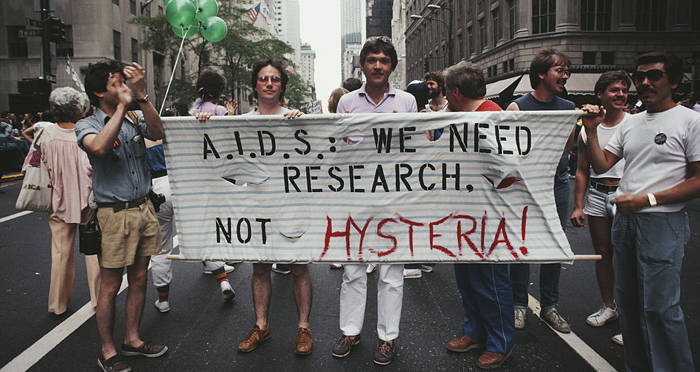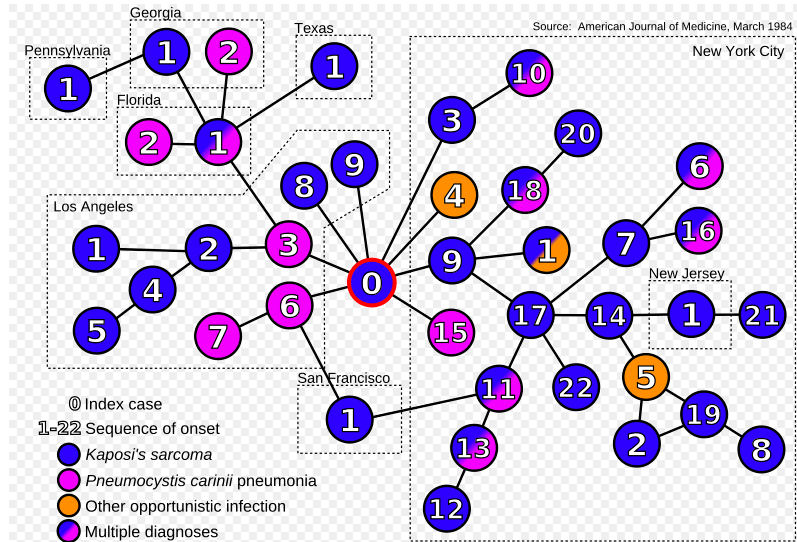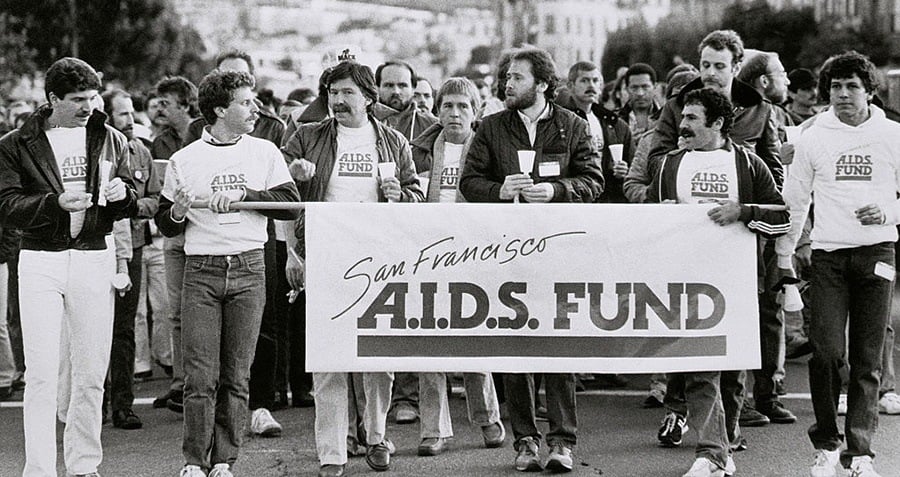The real Gaëtan Dugas was not the monstrous "AIDS Patient Zero" the media portrayed him to be — and even helped the CDC fight the disease.

Wikimedia CommonsFor decades, Gaëtan Dugas was wrongfully labeled as “AIDS Patient Zero,” the man who brought the disease to America.
Since the beginning of the AIDS pandemic, 35.4 million people have died of AIDS-related illnesses. And for a long time, one man, a Canadian flight attendant named Gaëtan Dugas, was considered as the person who brought the virus to America.
But the story of the so-called “AIDS Patient Zero” was actually a tragic misunderstanding — one that nevertheless persisted for years.
A Mysterious Illness

Getty ImagesMarchers in a Gay Pride parade through New York City, carry a banner that reads ‘A.I.D.S.: We need research, not hysteria!’ June 1983.
It all started in New York City in the early 1970s. Young, seemingly healthy men, were suddenly dying at alarming rates. Doctors could not understand the cause and as far as anyone could figure out, the victims only shared one common trait: They were all gay.
The strange illness seemed contained to a small group of gay men in New York at first. Soon, however, the number of infected men began to double each year until almost seven percent of gay men in New York were infected. In 1976, the first case was detected all the way across the country in San Francisco. Soon, the fear of a nation-wide pandemic caused much of the American public to descend into panic.
Early theories about this disease that we now know as AIDS (Acquired Immunodeficiency Syndrome) were bizarre: The New York Times even speculated that the mystery illness stemmed from “overexposure to sperm from many sources…having an immune-suppressant effect.” As the number of cases continued to grow without any sign of their source, the disease became a kind of stigma surrounding the American gay community.
Finally, in 1981, scientist William Darrow from the Center for Disease Control made a breakthrough.
After research revealed some of the infected men had been involved with each other sexually, Darrow began to suspect the syndrome might be a new kind of STD. Acting on his hunch, Darrow started asking his subjects about their sexual partners to try and see if there was a common link connecting the cases. Darrow’s suspicions were confirmed after several of the men each separately gave him the name of the same partner: Gaëtan Dugas.
Who Was Gaëtan Dugas, “AIDS Patient Zero”?

Le MondeGaëtan Dugas.
Born in 1953 in Quebec, Gaëtan Dugas was a handsome flight attendant who had begun working for Air Canada in 1974.
Darrow was able to trace eight of the cases reported in Los Angeles directly back to Dugas. The CDC quickly contacted him asking for his help in research in what they were now sure was a completely new sexually transmitted disease.
Dugas was more than happy to oblige. He flew to CDC headquarters in Atlanta and donated large amounts of his blood that would prove critical in future research.
He even volunteered to give the scientists an incredibly detailed list of some of his other partners who he thought might have been infected to help them trace the spread of the disease throughout the country. In total, Dugas estimated he’d had around 750 sexual partners over the past three years and provided the CDC with roughly 10 percent of their names.
The “charismatic,” “kind,” and “energetic,” but ultimately doomed young Canadian returned home to Quebec and decided to volunteer at a clinic for HIV-infected men in Canada. He passed away from AIDS-related complications in March of 1984, one month after turning 31.
Mapping The Origins Of AIDS

Wikimedia CommonsThe graph published in Darrow’s study showed the role Dugas played in bringing AIDS to the West Coast, but did not claim that he was the first infected patient.
That very same month, Darrow published his study on AIDS. The research attempted to prove that the disease, which was in fact an immune deficiency, spread through sexual intercourse. Darrow had laid out the path of the transmission in a diagram showing the disease’s spread from New York to California.
The study did not use any names but rather designated the infected men based on their locations. The patients in Los Angeles were therefore referred to as LA1, LA2, LA3, etc., while Dugas (who stood in the center of the diagram to show his role in the spread of the disease between the coasts) was dubbed “Patient O” (the letter, not the numeral) for “Outside of California.”
The American public at last had some answers about the fatal mystery disease. Yet, the publication of the CDC study did little to quell the panic. The furor only built up over the next few years as more and more people began contracting AIDS while the medical community made little progress in checking its spread.
Unfortunately, since the study had offered so little concrete information, AIDS continued to be viewed as a strictly “gay” disease that had spread so rapidly due to the promiscuous lifestyles of the community. Further cementing this stereotype was the publication of San Francisco Chronicle journalist Randy Shilts’ book And the Band Played On in 1987.
From “Patient O” To “Patient Zero”
https://www.youtube.com/watch?v=6kAXAIa1WQU
Similarly to Darrow, Shilts attempted to track the spread of AIDS throughout America. He had been covering the unfolding of the epidemic for a few years, earning praise from the gay community for propelling AIDS out of the shadows. Yet, in contrast to the CDC study, Shilts’ work was not solely scientific but took a moral stance on the spread of the disease, which he saw as the result of the callousness and unchecked pursuit of sexual partners by those who had the disease.
In particular, Gaëtan Dugas played the role of the central villain in Shilts’ tale, where he appears as a pleasure-seeking sociopath. Rather than willingly assist the CDC and volunteer his time, Shilts’ Dugas angrily responds “I’ve got it…they can get it too” when told he must stop frequenting gay bathhouses.
When Shilts interviewed employees at the CDC, they mistakenly referred to Dugas as “AIDS Patient Zero” rather than “Patient O,” the result of a small typo. Shilts recalled he thought “Ooh, that’s catchy” and seized upon the dramatic epithet for his book. This encouraged the implication that “AIDS Patient Zero” was the first man to contract the disease and was therefore responsible for its spread.
Meanwhile, And the Band Played On was a huge hit. The media was only too eager to portray Gaëtan Dugas as “AIDS Patient Zero” and “The Man Who Gave Us AIDS.” The very notion of “AIDS Patient Zero” became a staple of everyday conversations and the portrait Shilts painted of Dugas soon overshadowed the truth.
The Aftermath

Getty ImagesNearly 2,000 people participate in an annual candlelight parade devoted to gay and lesbian pride and the social concerns surrounding AIDS.
In a twist of tragic irony, Shilts himself also passed away from AIDS-related complications in 1994, by which time the worst stereotypes about the disease and the American gay community were already an integral part of the popular imagination. It would take two more decades and advancement in scientific research to finally clear the name of Gaëtan Dugas.
In the following years, as scientists continued to study the immunodeficiency disease and get the epidemic under control, several new facts came to light.
Thanks to advances in genetic analysis, a 2016 study of Dugas’s blood revealed that the strain of HIV he had carried existed in several other gay men in New York well before he first visited the city in 1974. Part of the difficulty in tracing the origins of the disease stems from the fact that it has a long incubation period, meaning it can go undetected for a long time.
Modern researchers were able to confirm that the strand of HIV that triggered the American AIDS epidemic was first carried over from Africa to Haiti by civil servants in the late 1960s, before finally arriving in the United States circa 1971.
Although the scientific data has proven that Gaëtan Dugas was not responsible for the spread of AIDS, the “AIDS Patient Zero” story has been circulated for so long that it may still yet take much longer to get rid of the stigma attached not only to Gaëtan Dugas, but also to the gay community as a whole.
Next, read more about the truth behind the spread of AIDS in the United States. Then, find out about the single photo of David Kirby that changed the way Americans viewed AIDS.





